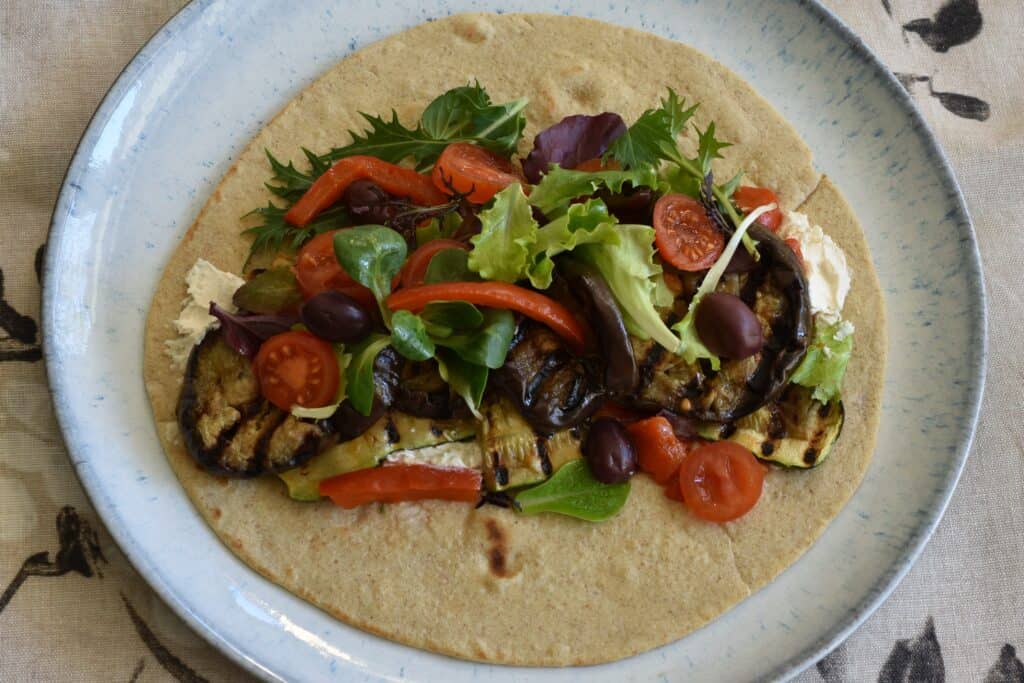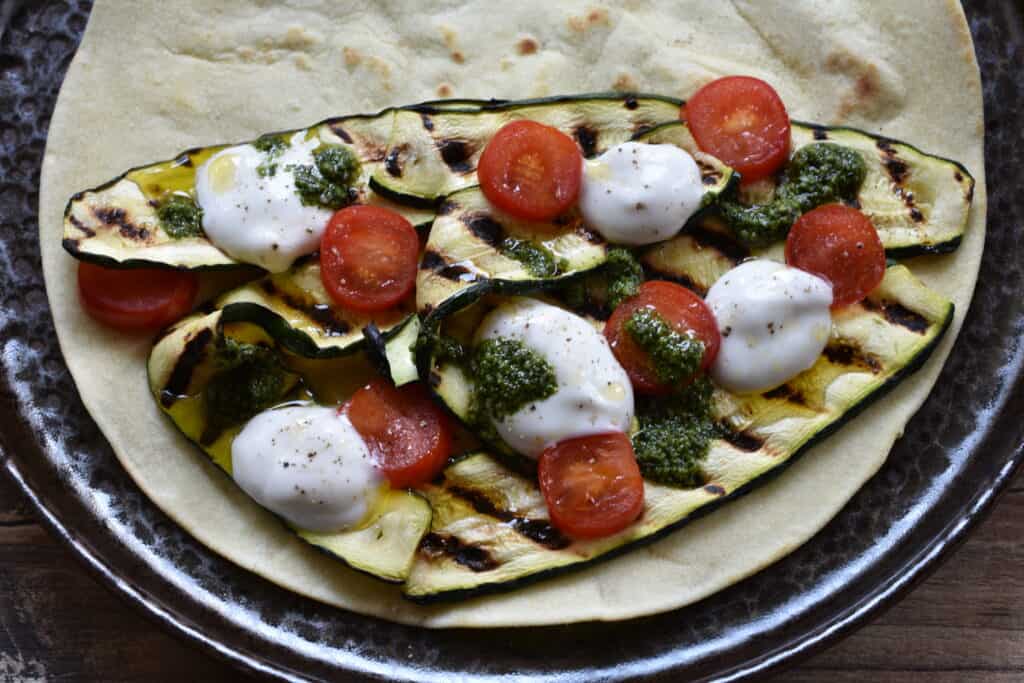Piadinas are Italy’s answer to flatbread and in this post, you’ll learn how to make them quickly and easily at home with just five ingredients! Why go out and buy them when you can make better ones at home with all-natural ingredients?! It’s one thing to eat a piadina in a piadineria in Emilia Romagna – which is a truly wonderful experience – but it’s quite another to eat one elsewhere, unfortunately, especially outside Italy. That’s why I recommend you make your own!

All about piadinas
As usual, I’ve been down a culinary rabbit hole again, researching facts. So for those of you who are curious, read on. If you can’t wait to make your piadinas, feel free to jump to how to make them!
The original piadina romagnola is an unleavened flatbread hailing from the region of Emila Romagna in Italy. As with all regional recipes, there are several variations. Thickness and diameter may vary, but they are all made with flour, water, lard (heaven forbid!) or extra virgin olive oil (we’ll be using that), salt and bicarbonate of soda.

Piadina, or piada as it was first known, originates from the historical towns of Forlì, Cesena, Ravenna and Rimini, in Emilia Romagna, and is now considered part of Italy’s culinary heritage. The flatbread was traditionally cooked on a terracotta dish called a teggia or testo, although nowadays, flat pans or electric griddles are commonly used. At home, all you’ll need is a large frying pan or griddle.
Piadine romagnole are usually made with white flour and are thicker and smaller than piadine Riminesi (from the town of Rimini). In supermarkets throughout Italy, you’ll find the original piadina romagnola, as well as variations made with wholemeal flour, Khorasan kamut, or farro.

Piadine romagnole – IPG certification
True piadine romagnole are certified IGP, which stands for Indicazione Geografica Protetta. This is similar to DOC for wines and means that a piadina may only be called romagnola if it is produced in Emilia Romagna and conforms to standards set locally and by the European Union.
In this post, you’ll learn how to make piadinas quickly and easily in the comfort of your own home, using whichever flour best suits your tastebuds and dietary requirements. From 100% white to 100% wholemeal, as well as kamut, farro, and everything in between! So, get your kitchen scales out and let’s get started!

How to make piadinas at home
Piadinas are one of the first things I learnt to make at home during lockdown boredom. Like many other things, piadinas were something that I occasionally bought from the supermarket. More for my family than for myself, I have to say. I found them floury, chewy, and a bit indigestible. Lockdown meant no more supermarket piadinas because we couldn’t cross the border to Italy. So, one evening, I decided to try making them.
I looked up a couple of recipes on the internet and immediately felt my hackles rising. The first said lard… so I hastily closed the page. The next said lard from a certain breed of pig raised only in Emiglia Romagna… (no comment). The third said, “Knead the dough using (a certain movement of the elbow and shoulder)” – which I didn’t understand (or even want to understand). Needless to say, by this time, I was feeling really hot under the collar. So I grabbed my hand mixer and dumped the ingredients on the scales, substituting lard with extra virgin oil. Five minutes later, I had what looked like a decent dough with a good consistency. I made a couple of minor changes after that, which brought me to the happy conclusion I’m sharing with you today.
Savings are huge, obviously, compared to shop-bought piadinas. But it’s all about taste and consistency to me. This piadina recipe is guaranteed to leave you feeling satisfied and accomplished!

Ingredients
You’ll find the exact quantities of each ingredient in the recipe card at the end of this post.
- Flour – The choice of flour is down to personal taste. I regularly make piadinas made of 100% white, 100% wholemeal, and other percentage ratios of white and wholemeal, like 50/50, for example. I really like farro and often use it for making piadinas, either on its own or mixed with white flour. Khorasan kamut is another, gluten-free, option. Whatever flour combination you choose, you shouldn’t need to modify the quantities indicated in the recipe card below.
- Water – Tap water is fine for making piadinas.
- Extra virgin olive oil
- Salt – I recommend you use unrefined sea salt.
- Bicarbonate of soda – also known as baking soda in the US. Bicarbonate of soda is optional, but it does make the piadinas lighter.
Instructions
- Weigh the ingredients and put the flour, salt, and bicarbonate of soda into a bowl and mix well.
- Add the water and oil and mix with a spatula until the dough comes together (see notes in the recipe card below). Take the dough and place it on a clean worktop.
- Without adding extra flour, knead the dough on the worktop for 5 minutes until smooth and elastic.
- Weigh the dough and split it into four pieces of equal weight or size.
- Using the palm of your hand, rotate each piece between your hand and the worktop, exerting a moderate amount of pressure for about 20 seconds to form a compact ball.
- Place the balls of dough close to each other on the worktop. Leaving a space of a centimetre or two between them so that they don’t touch. Cover with the bowl you used before, or some clingfilm, and leave to rest for 30 minutes.
- In the meantime, prepare the ingredients for the filling.
- After 30 minutes have passed, preheat your griddle pan or large frying pan. While you’re waiting for it to heat up, sprinkle a little flour on a clean worktop and roll out your first piadina to a diameter of approximately 22-23 cm (about 9″). Sprinkle flour as necessary, on top and underneath, to prevent it from sticking to the surface.
- Once the pan is very hot, turn the heat down to medium/hot. On my ceramic glass cooktop, I use one of the large rings and keep the heat constant at number 6. Peel the piadina off the worktop and lay it flat in the pan. Do not use any oil – the pan must be dry. Leave it for about 45 seconds, pressing down on it gently with a slotted turner until bubbles appear and golden brown dots form on the underside.
- Turn the piadina and cook the other side for another 45 seconds, approximately. While the first piadina is cooking, roll out the second one. Repeat until all the piadinas are done. Your piadinas should be cooked but still pliable. You’ll need to be able to roll up your filling. If, by any chance, you overcook them and they become brittle, you can still use them! Simply fold them in half instead of rolling them.

Vegan piadina fillings
Feel free to fill your piadinas with your favourite ingredients! Piadina is Italian, so I usually go for Mediterranean flavours! Here are some of my favourite vegan fillings – Italian style!

- grilled aubergines, grilled courgettes, grilled red peppers, hummus.
- grilled courgettes, vegan tuna, lettuce, tomato, vegan mayo, olives.
- vegan tuna, avocado (seasoned with lemon juice, salt and pepper), spring onion, tartare sauce, iceberg lettuce.
- grilled aubergines, tomato, mixed leaf salad, vegan mayo, mustard.
- grilled aubergines, grilled courgettes, grilled peppers, vegan stracchino or vegan cream cheese, olives, rehydrated sun-dried tomatoes, radicchio or iceberg lettuce.
- avocado, tomato, rocket, vegan stracchino, olives.
- grilled red peppers, hummus, sundried tomatoes, mixed leaf salad.
- grilled artichokes, cashew cream cheese, radicchio or lettuce, vegan mayonnaise.

How to store your homemade piadinas
Put your piadinas one on top of the other and slide them into a ziplock bag. Remove the excess air and close the bag. Place them flat on a shelf in the fridge. They will keep like that for a week.
Alternatively, you could freeze them. However, bear in mind that once frozen, they become very brittle and break easily. So you’ll have to be careful every time you rummage around in the freezer. Piadinas will keep well for a couple of weeks in a domestic freezer. Of course, technically, it is possible to freeze them for much longer, but I find that bread, focaccia and flatbreads don’t keep well for long periods in the freezer. Baking products tend to suffer from freezer burn, which ultimately changes the texture of the food. I personally never freeze mine.
I hope you found this post on how to make piadinas useful! If you did, it would be great if you could give it a star rating and leave a comment below! It helps other readers to find my content and posts and ultimately makes my blog more successful! Thanks so much for your support! Deborah xx
While you’re here on Vegan Hot Stuff, maybe you’d like to take a look at some other popular recipes…






Would you like to receive my recipes as soon as I publish them? Subscribe below!

















Davvero Gustose ?
Bene, sono contenta!